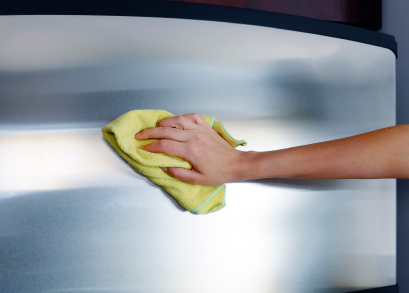As a scientist and a jewelry artist, there are not that many occasions when my two passions overlap. As a geneticist, I find the evolution and spread of antibiotic resistant microbes to be fascinating in a “this is really cool and utterly terrifying” sort of way. As a jewelry artist, I love experimenting with new and different metals. Some of my current favorites are stainless steel, copper and bronze, which is an alloy of copper and tin. So you might be able to imagine my excitement when I came across an article in mBio discussing the public health implications of horizontal gene transfer (HGT) of antibiotic resistance genes on clinical and public touch surfaces made from copper alloys compared to those made of stainless steel (1).
Stainless steel: The unexpected, gene-transferring truth
 Stainless steel is often used in clinical and public settings as work surfaces as well as other surfaces that are touched and cleaned often. Stainless steel is used in these applications for many of the same reasons I like it for jewelry: it is strong, resilient, relatively inexpensive, stain- and corrosion-resistant and will weather regular cleaning/exposure to moisture well. There is something about a gleaming stainless steel work surface that looks, well, sterile. But is it?
Stainless steel is often used in clinical and public settings as work surfaces as well as other surfaces that are touched and cleaned often. Stainless steel is used in these applications for many of the same reasons I like it for jewelry: it is strong, resilient, relatively inexpensive, stain- and corrosion-resistant and will weather regular cleaning/exposure to moisture well. There is something about a gleaming stainless steel work surface that looks, well, sterile. But is it?
The answer is no. There are a number of pathogens that have been shown to survive for prolonged periods of time on stainless steel and other dry surfaces, and microscopic striations on what appears to be a smooth surface can harbor microorganisms and even allow them to evade cleaning procedures (2). Given these facts, the authors of the mBio paper decided to investigate if HGT could occur on stainless steel surfaces. Their results were not encouraging.
The authors used an azide-resistant strain of E. coli as the recipient strain and two different donor antimicrobial-resistance organisms, the E. coli strain ST131 that harbors extended-spectrum-β-lactamase (ESBL), and a K. pneumonia strain that produced the metallo-β -lactamase NDM-1 (resistant to carbapenemases). They compared the frequency of gene transfer and the stability of the transconjugates on a solid surface to those of the cells in suspension.
In suspension, gene transfer from the ESBL E. coli strain occurred as soon as the cells were mixed, the conjugation frequency didn’t change after 2 hours, and all the transconjugants were stable. On stainless steel, the frequency of conjugation was twice that of the cells in suspension, but not as many transconjugants were stable. After 2 hours, there was no increase in gene transfer, which implies that the significant transfer occurred as soon as the cells were mixed.
Gene transfer from K. pneumonia occurred at a much lower frequency compared to E. coli. Transfer did occur upon mixing, but none of the transconjugates were stable. However, after 2 hours, stable transconjugates were produced both in suspension and on stainless steel surfaces. In addition, HGT of carbapenemase genes often includes flanking genes as well. These genes can include ones that confer resistance to other antimicrobials as well as ones that affect expression (e.g., multiple promoters). In this study, the authors found that all the transconjugates shared the same multidrug resistance profile as the donor K. pneumonia strain, suggesting multiple-gene transfer took place.
At this point in the paper, the authors had thoroughly convinced me that the clean, sterile feel of stainless steel surfaces was an illusion. Having established that stainless steel surfaces are not necessarily as clean as they appear and that microbes that may be living on those surfaces are very likely swapping genes, the authors turned their attention to surfaces made of copper or copper alloys. And this was where the paper really grabbed a hold of me.
Copper: The transfer-inhibiting, DNA-degrading microbe killer
 Copper surfaces are already known to reduce microbial populations, possibly through the release of copper ions that effect microbe growth and respiration. The first question the authors asked was, do the microbes exchange genes on dry copper surfaces?
Copper surfaces are already known to reduce microbial populations, possibly through the release of copper ions that effect microbe growth and respiration. The first question the authors asked was, do the microbes exchange genes on dry copper surfaces?
Gene transfer from the ESBL E. coli strain did occur almost immediately upon mixing on the copper surfaces, but there was a significant (although small) number of the transconjugates that were unstable. There were no stable transconjugates found after 2 hours of contact, the authors presume that this is due to the antimicrobial properties of the copper.
For the K. pneumonia NDM-1 strain, the authors found no transconjugates immediately upon mixing on copper surfaces, just as they found in suspension and on stainless steel. However, unlike stainless steel, there were also no transconjugates after 2 hours on the copper surfaces. These results suggest that copper surfaces could help reduce the opportunity that these microbes have to swap antibiotic resistant genes.
The authors further evaluated the ability of E. coli to survive on copper and copper alloy surfaces in a wet inoculate of PBS or a complex of carbohydrates, proteins and lipids (to represent naturally occurring soils). Cells on dry surfaces were all dead with in 20 minutes for all the copper alloys tested. Cells inoculated on the surface in PBS were dead with in 30 minutes on copper and copper nickel (89% copper) and by 90 minutes for all the other alloys tested (copper content ranging between 60 and 95%). When cells were inoculated in a high-lipid complex, cells on copper and copper nickel were dead within 2 hours and there was a 3- to 4-log reduction in viable cells on all other alloys. Similar results were seen with K. pneumonia, although the times to death were somewhat longer.
By now I hope that some of you are as in love with copper containing surfaces as I am, but it gets even better. The authors also looked at what happens to the plasmid DNA of β-lactamase producers on copper and stainless steel surfaces. There was little effect on the plasmid DNA on the stainless steel surfaces, but on the copper surfaces, there was massive DNA degradation within 10 minutes of contact (from 1.5kbp to an average size of 300bp).This means that plasmids containing the antibiotic resistance cannot remain intact on these surfaces to be incorporated into other microbes.
I love using stainless steel in my jewelry designs because it is strong and practically indestructible. And although a solid copper work surface would not be practical, after reading this paper every time I see a “sterile” stainless steel surface, I keep thinking, wouldn’t that be beautiful in copper?
References
- Warnes, S.L., Highmore, C.J. and Keevil, C.W. (2012) mBio 3(6), e00489–12.
- Guet-Revillet, H. et al. (2012) Am. J. Infect. Control 40, 845–8.
Author’s Note: To maintain a constant killing surface, copper and copper alloy surfaces would need to be cleaned using the proper protocols including the use of nonchelating substances to ensure the continued release of copper ions.
Kelly Grooms
Latest posts by Kelly Grooms (see all)
- The Battle of Shiloh’s Angel’s Glow: Fact, Civil War Legend or Modern Myth? - July 11, 2024
- Mind Control, Mutilation and Death. The Fungal Fate That Lurks in Waiting for Emerging Periodical Cicadas - June 13, 2024
- Measles and Immunosuppression—When Getting Well Means You Can Still Get Sick - May 13, 2024
